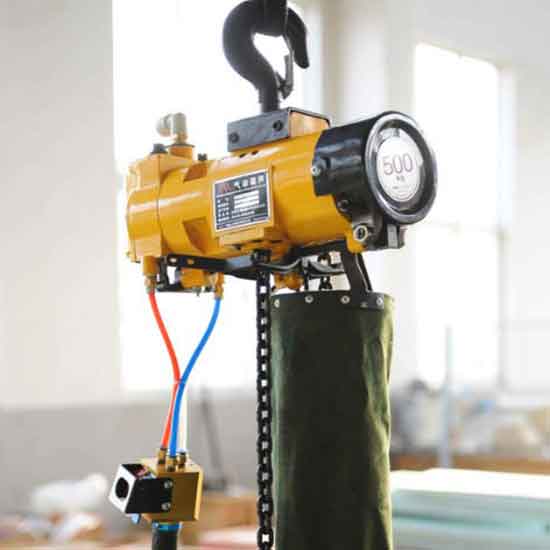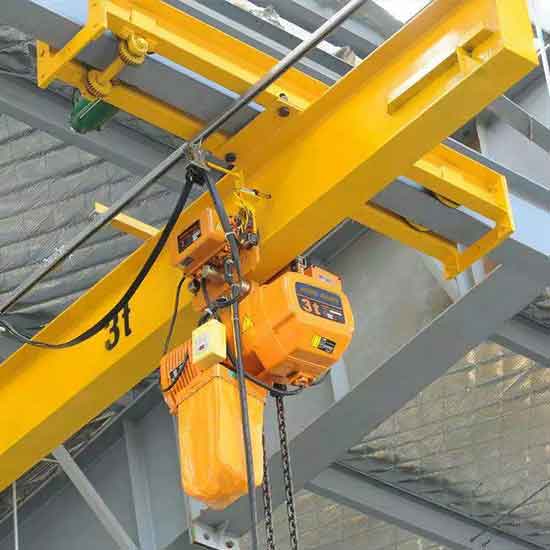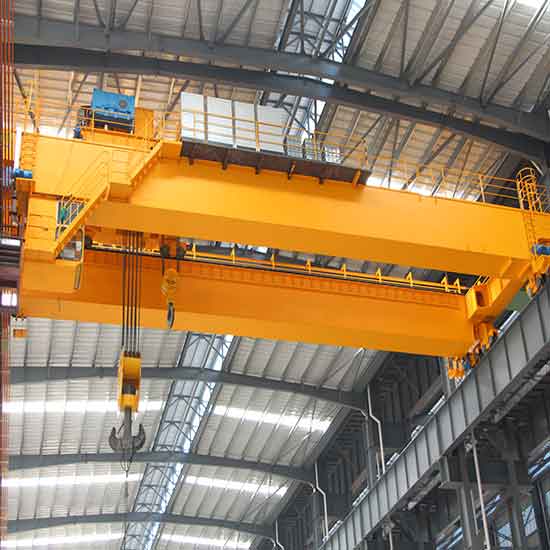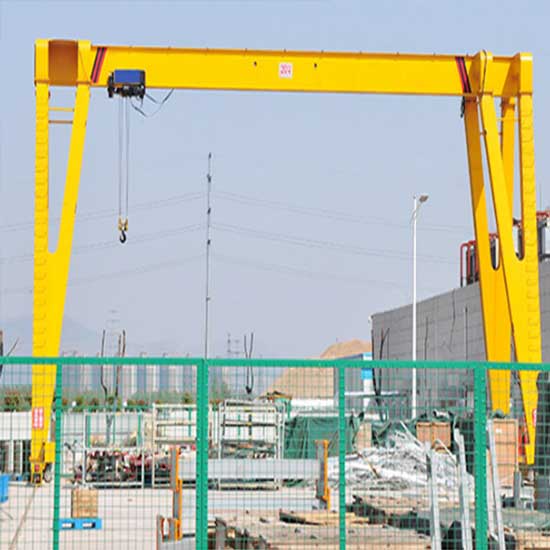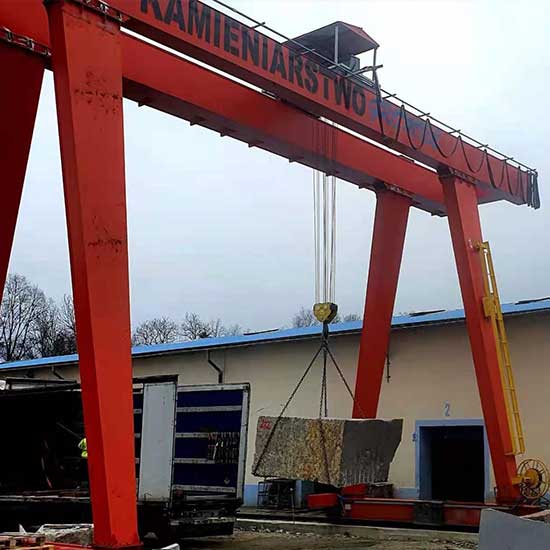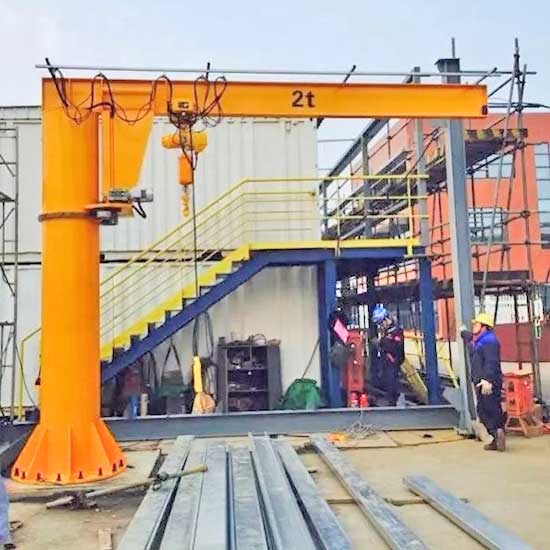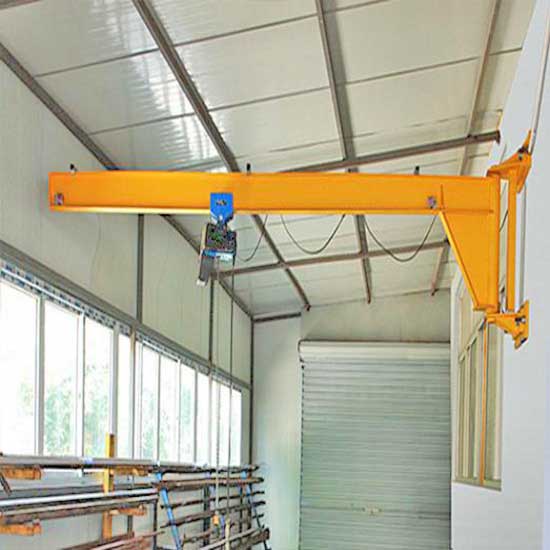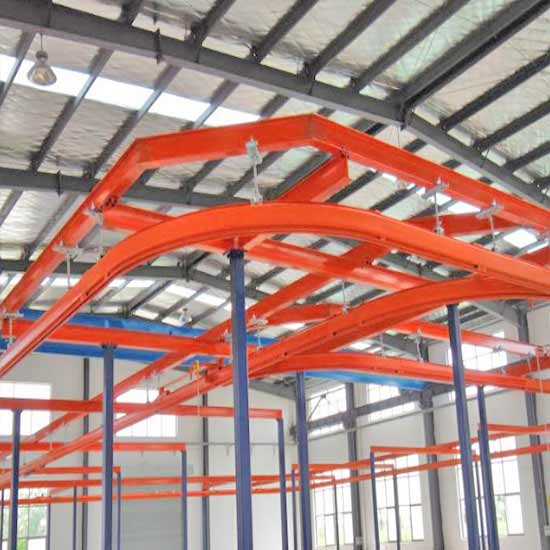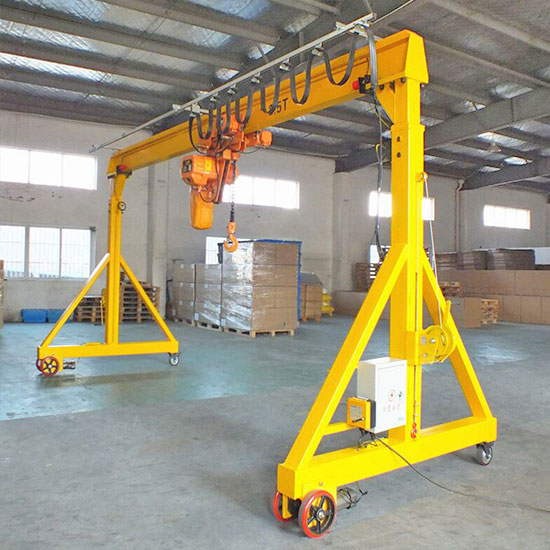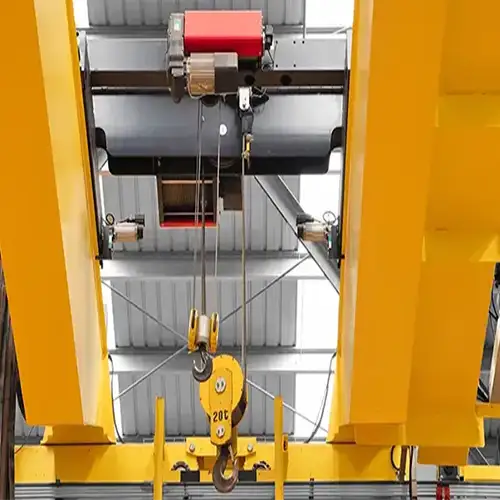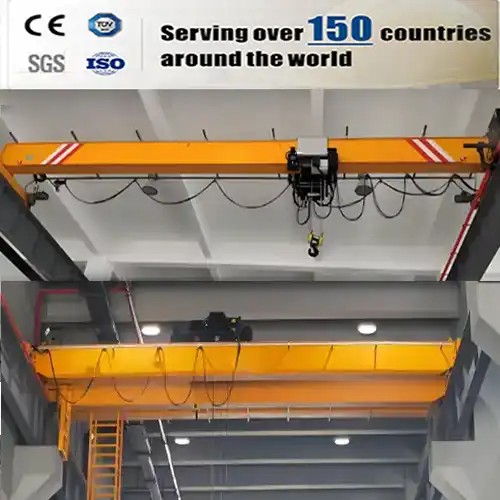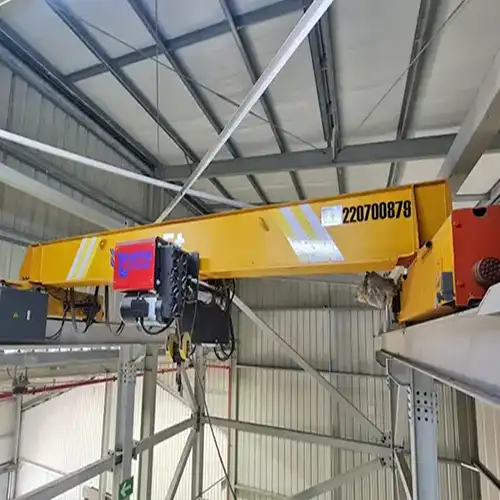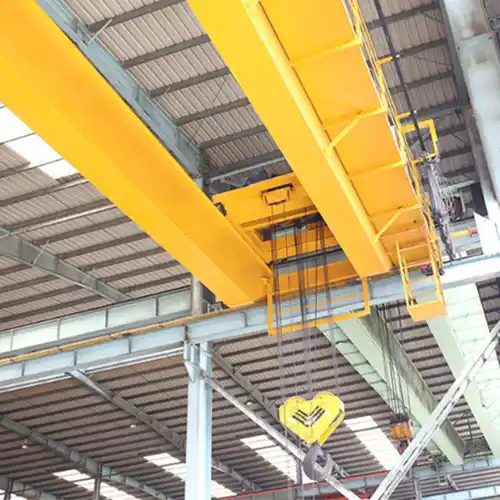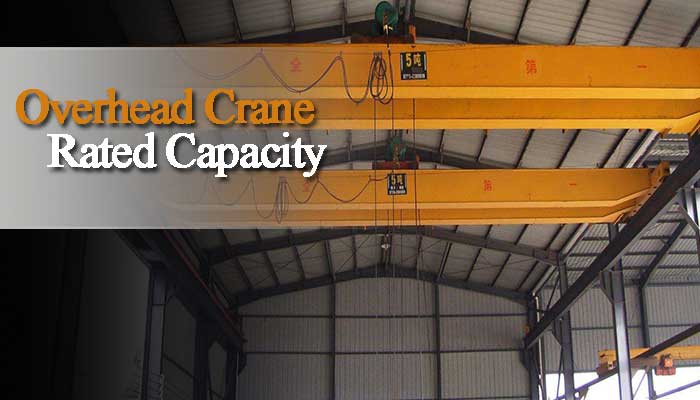
What Is Overhead Crane Capacity & Working Load Limit?
The use of Rated Capability to rate the lifting capacity of cranes, hoists, and winches is now encouraged by standards bodies throughout the developed world.
The maximum total load that a crane can lift for a given configuration is referred to as its rated capacity.
The Maximum Rated Capacity (MRC) or Manufacturer's Rated Capacity are two terms for the same thing.
The capacity that has been determined is as follows:
"the weight that the crane is intended to hoist in a given operating situation" (e.g. configuration, position of the load). The hook block's mass (weight) is included in the load for cranes."
Simply described, an overhead crane's Rated Capacity is the total weight that can be lifted by the crane's lifting device. The Gross Load of the crane is the total mass being lifted, whereas the Net Load is the actual mass being lifted.
In most manufacturer's Lifting Charts (used to calculate a crane's Rated Capacity in a specific configuration), the Gross Load includes the hook block, any jib extension stowed away on the boom (i.e. not in use), and any lines not actually required to lift the Net Load for some cranes with multi lift lines. Depending on the complexity of the crane and needed lift arrangement, extending booms, optional jigs, outriggers, counter weights, lift radius, lift angle, and other factors determine the crane's Rated Capacity. The monetary value (advertised) A crane's maximum rated capacity usually refers to the maximum Net Load it can lift under ideal conditions (shortest boom length, minium lift radius, optimum lift angle, out riggers extended, etc.)
A piece of lifting equipment's Rated Capacity is determined by the manufacturer. Any requirement to "derate" (alter a piece of equipment's Rated Capacity) it should only be done by a qualified person (engineer) following consultation with the manufacturer.
Working Load and Working Load Limit
Working Load Limit (WLL) for lifting attachments such as hooks, slings, and shackles is currently encouraged by standards agencies in the industrialized world.
The "load on the hook plus mass (weight) of the hook and block" (as specified in BS EN 13000:2004, Cranes – overhead cranes) is referred to as a Working Load.This is a concise definition for a Working Load on a crane line, however it does give us an understanding of what the Working Load for any lifting gear, accessory or component should be. That is, the Working Load for any component is the load on the component plus the mass (weight) of the component itself.
Working Load Limit (WLL)
The maximum Working Load for an accessory in a defined configuration under expected or normal working conditions is referred to as a Working Load Limit.
It's computed by dividing the Minimum Breaking Load (MBL) required to fail or permanently deform and weaken that piece of equipment by a Safety Factor (FoS). The Factor of Safety of a piece of equipment is determined by its construction, the danger of death, and the predicted operating conditions (wear, corrosion, dynamic loads, inspection periods).
The total Gross Capacity for a lift configuration is determined by the lowest WLL for any component or collection of components functioning together within that configuration.
The manufacturer of a piece of equipment determines the Working Load Limit for that piece of equipment. Any obligation to "derate" (alter a piece of equipment's WLL) should only be carried out by a qualified person (engineer) after consultation with the manufacturer.
Putting Safety First
For a needed configuration, the Gross Load should never exceed the SWL (Safe Working Load), MRC, or WLL. Using the safety margin or FoS to just "get the job done" risks failure and injury not only during the lift itself, but also in the future under normal or, more importantly, critical lift conditions. It is not acceptable to believe that "this time will be different; the risk of injury or damage will be less." Exceeding a piece of equipment's SWL, MRC, or WLL may diminish its Minimum Breaking Load for the following work or a vital lift months down the road, when the hazards are much higher.Abusing a piece of equipment can drastically lower its estimated working life, resulting in higher long-term costs.
Capacity Markings
The original equipment manufacturer (OEM) designs and builds all components of an overhead handling system, including cranes, hoists, and monorails, to sustain a maximum rated load. The load capacity of any piece of equipment is usually measured in tons and should never be exceeded. The duty cycle of an overhead handling component is also determined by the load capabilities of the components.
As a precaution, each component should be labeled with signs, known as capacity markings, that informs the operator of the maximum load for which the equipment was designed and manufactured by the manufacturer. The possibility of an operator attempting to raise something heavier is lowered by presenting a visible reminder of a piece of overhead lifting equipment's maximum capacity. This improves the operation's safety as well as the safety of workers working near the crane, hoist, or monorail system.
The proper usage and application of capacity markers is subject to a number of conditions:
- "The rated load of the crane shall be plainly marked on each side of the crane, and if the crane has more than one hoisting unit, each hoist shall have its rated load marked on it or its load block, and this marking shall be clearly legible from the ground or floor," according to the Occupational Health and Safety Administration standard number OSHA 1910.179(b)(5).
- "The rated load shall be indicated on either side of the crane, and if the crane has more than one hoisting unit, each hoist shall have its rated load marked on the hoist and its load block so that the rated load marking shall be legible from the ground or floor," according to ASME B30.17-1.1.1 Cranes.
- "The rated load of the monorail should be marked on the monorail and, if marked, shall be legible from the ground or floor," according to the ASME B30.17-1.1.2 Monorails standard.
- "The rated load of a hoist shall be marked on the hoist or its load block and shall be legible from the ground or floor," according to the ASME B30.16-1.1.1 Hoists standard.
Using straightforward, unambiguous English with bold lettering large enough to be visible from a distance is one of the best practices for applying capacity markers. The placing of rated load capacity marks on both the hoist and its load block on hoists in particular (although if only one of the two is labeled, it should be the load block). Overhead cranes, which should be labeled on both sides so that they can be seen from both directions, require large, highly visible markings. Similarly, the rated load of monorails should be clearly indicated on both sides of the system.
As one of numerous pre-operational checklist items, the operator should evaluate and verify the presence and readability of capacity marks on each component before employing a crane, hoist, or monorail system. If a problem is discovered, the unit (or units) should be taken out of operation as soon as possible.
Lifting capacity / rated lifting capacity of overhead crane
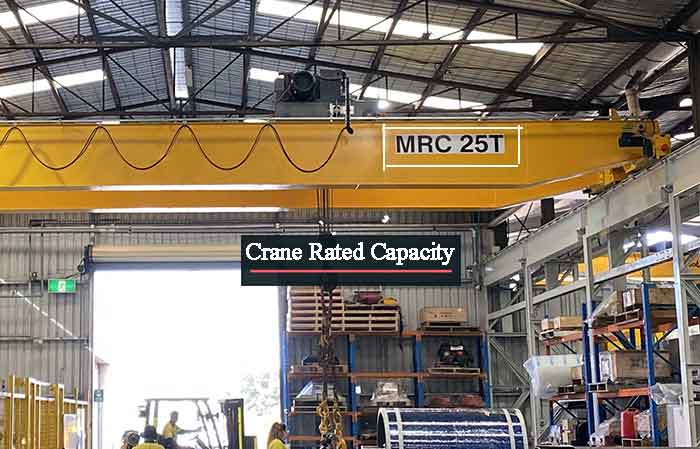
The lifting capacity or rated lifting capacity of a crane is commonly referred to as the lifting weight G. It refers to the maximum weight that a crane can lift safely and stably under normal working conditions. The lifting capacity of a crane is determined by its structural design, such as the length of its boom, the strength of its wire ropes, and the capacity of its hoisting mechanism. The lifting capacity is usually expressed in metric tons (t) or kilonewtons (kN).
- Rated lifting capacity Gn refers to the total weight of the material that the crane can lift along with any detachable lifting equipment or attachments such as grab buckets, electromagnetic suction cups, balance beams, etc.
- Total lifting capacity Gz refers to the total weight of the material that the crane can lift along with any detachable lifting equipment and fixed lifting equipment and devices that are permanently attached to the crane (including hooks, pulley blocks, lifting steel wire ropes, and other lifting devices below the crane trolley).
- Effective lifting capacity Gp refers to the net weight of the material that the crane can lift.
Note:The parameters need to be explained as follows:
- First, the lifting capacity marked on the crane nameplate usually refers to the rated lifting capacity of the crane, which should be prominently displayed on an obvious position of the crane structure.
- Second, for jib type cranes, the rated lifting capacity varies with the amplitude, and its lifting characteristic index is characterized by the lifting moment. The value marked on the label is the maximum lifting capacity.
- Third, for cranes with detachable spreaders (such as grab buckets, electromagnetic suckers, balance beams, etc.), the total rated lifting capacity of the spreader and the mass of the material, the mass of the material allowed to be lifted is the effective lifting capacity.
In the following there are other several terms presented for your reference:
- Design Capacity: This refers to the maximum weight that an overhead crane is capable of lifting under ideal conditions, such as when the crane is new and all components are functioning properly.
- Safe Working Load (SWL): This is the maximum weight that an overhead crane is designed to lift safely under normal operating conditions. It takes into account factors such as the crane's age, condition, and maintenance history.
- Ultimate Capacity: This refers to the maximum weight that an overhead crane can lift before failure occurs. It is generally much higher than the safe working load and is used for testing purposes only.
- Rated Capacity: This is the maximum weight that an overhead crane is designed to lift under specific conditions, such as a particular span or lift height. It is typically lower than the ultimate capacity.
- Loaded Capacity: This refers to the weight of the load being lifted by the overhead crane.
- Maximum Capacity: This is the highest weight that an overhead crane can lift under any circumstances. It is typically higher than the rated capacity.
- Overlifting capacity: This refers to the maximum weight that an overhead crane can lift in an emergency situation, such as when a load needs to be moved quickly to prevent an accident.
These different capacity terms are related to each other in that they reflect different aspects of an overhead crane's lifting capacity. The design capacity and ultimate capacity are theoretical limits, while the safe working load, rated capacity, and overlifting capacity are practical limits that take into account real-world conditions. The loaded capacity and maximum capacity relate to the weight of the load being lifted, while the other terms relate to the capabilities of the crane itself. It's important to understand these different capacity terms and how they relate to each other in order to operate overhead cranes safely and effectively.
When purchasing or selecting an overhead crane, all capacity-related factors are important, but the most critical factor depends on the specific application and intended use of the crane. For most applications, the safe working load (SWL) is the most important capacity factor to consider. This is because the SWL reflects the maximum weight that the crane can lift safely under normal operating conditions, taking into account factors such as the crane's age, condition, and maintenance history.
The other capacity-related factors, such as the design capacity, ultimate capacity, rated capacity, loaded capacity, maximum capacity, and overlifting capacity, are also important to consider when selecting an overhead crane. These factors can impact the crane's performance and safety, and they may be relevant in specific applications or under certain conditions. More on Basics of overhead crane specifications, definitions & terms for reference to get custom overhead crane, gantry crane, jib crane & other hoists and cranes.
What are the factors affect overhead crane capacity ?
The capacity of an overhead crane can be affected by several factors, including:
- Design: The design of the crane, including the size and strength of its components, can impact its lifting capacity.
- Age and condition: The age and condition of the crane can impact its capacity, as wear and tear can weaken the crane's components over time.
- Maintenance history: Proper maintenance is essential to ensure that the crane is functioning at its full capacity. A lack of maintenance can lead to decreased capacity and potential safety hazards.
- Operating environment: The environment in which the crane operates can impact its capacity. For example, high temperatures or corrosive substances can weaken the crane's components.
- Load characteristics: The weight, size, and shape of the load being lifted can impact the crane's capacity. Loads that are off-center or unbalanced can put additional stress on the crane's components.
- Duty cycle: The frequency and duration of use for the crane can impact its capacity. Cranes that are used frequently or for extended periods may have a lower capacity than those used less frequently.
- Regulatory requirements: Depending on the application, there may be regulatory requirements that impact the crane's capacity, such as safety standards or weight limits.
It's important to consider all of these factors when selecting and operating an overhead crane to ensure that it is safe, reliable, and capable of meeting the specific needs of its intended application.
How to calculate overhead crane capacity you need?
To calculate the overhead crane capacity you need, you should consider the following factors:
- Weight of the load: Determine the maximum weight of the load that you need to lift. This should include the weight of the load itself, as well as any attachments or rigging.
- Load center of gravity: Determine the center of gravity of the load, as this can impact the stability and capacity of the crane.
- Lift height: Determine the maximum height that you need to lift the load.
- Span: Determine the distance between the centerlines of the runway rails or support columns.
- Duty cycle: Determine the frequency and duration of use for the crane, as this can impact its capacity.
- Safety factors: Consider any safety factors that may impact the crane's capacity, such as regulatory requirements or safety standards.
Once you have determined these factors, you can use a crane capacity calculator or consult with a qualified engineer to calculate the appropriate capacity for your overhead crane. It's important to ensure that the crane's capacity is appropriate for the intended application and that the weight of the load being lifted does not exceed the crane's capacity to prevent accidents or damage to the equipment.
Formula to calculate the SWL overhead crane capacity
The formula to calculate the overhead crane capacity depends on the type of crane and the specific application. However, here is a general formula that can be used to calculate the safe working load (SWL) of an overhead crane:
SWL = (Crane weight + Maximum load weight) x Crane duty factor
Where:
- Crane weight: The weight of the crane itself, including the trolley, hoist, and any other components.
- Maximum load weight: The maximum weight of the load that the crane is designed to lift.
- Crane duty factor: A factor that takes into account the frequency and duration of use for the crane. This factor is typically provided by the manufacturer and can range from 1.25 to 1.5.
For example, if a crane has a weight of 10,000 pounds, a maximum load weight of 20,000 pounds, and a duty factor of 1.25, the SWL would be:
SWL = (10,000 + 20,000) x 1.25 = 37,500 pounds
It's important to note that this is a general formula and that the actual capacity of an overhead crane can vary depending on its design, components, and intended use. It's also crucial to ensure that the weight of the load being lifted does not exceed the crane's capacity to prevent accidents or damage to the equipment.
Overhead crane capacity of different types for your reference
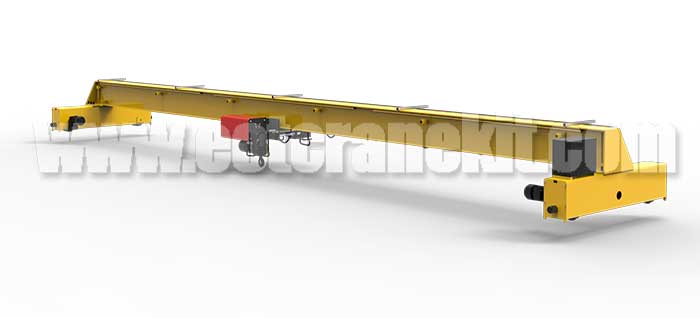
The main specification of main tyeps of mold of single girder overhead crane made in China are presented for your reference.
- HD - single girder overhead crane with European style monorail hoist with capacity up to 1 ton -16 ton
- LD / LDA - electric single beam crane with economical cd/md wire rope hoist with capacity up ton 20 ton .
- NLX - single girder electric overhead crane with underhung crane design with capacity from 1 ton to 10 ton.
- LX— electric single girder suspension crane with capacity from 1 ton to 10 ton.
- LB— Explosion-proof electric single beam crane for hazardous environment to ensure safety.
- LDY—Metallurgical Electric Single Girder Crane for hot ladle handling for small steel mill with capacity form 1 ton to 10 ton.
- SL— Manual Single Beam Crane & SLX—Manual Single Girder Suspension Crane
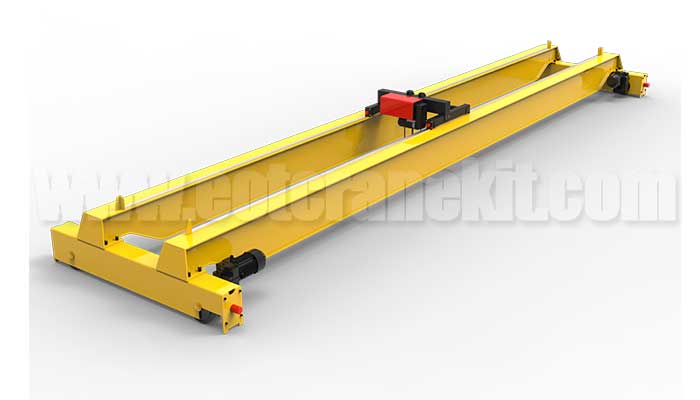
Double girder overhead crane with European style with lifting capacity of 3 ton - 80 ton
The main specifications of main types and molds of double girder bridge cranes made in China are as the following :
- NlH — Double girder electric hoist overhead crane with European style design with capacity of 3 ton -80 ton, with lower profile than LH type.
- LH— Double Girder electric hoist bridge crane with CD/MD wire rope hoist trolley, with capacity of 3 ton -63 ton, cheaper solution than NLH.
- QDX — Double girder overhead crane with European style open winch trolley with capacity of 3 ton -320 ton lower headroom with QD type hook crane.
- QD —Universal Double Girder Hook Overhead Crane for General Use with capacity from 3 ton to 550 ton
- QDY —Casting bridge crane for hot ladle handling with capacity of 3 ton -74 ton
- YZ — Double Girder Overhead Casting Crane with Capacity of 75 ton -320 ton
- QZ— Grab bridge crane with double girder crane design with orange peel grab or clamshell grab bucket for bulk loads handling
- QB— Explosion-proof bridge crane with explosion proof design for hazardous applications with capacity of 5 ~ 75 tons
- QE— Double Girder bridge crane with Double Open Winch for Tandem Lifting with capacity of f (2.5+2.5)~(200+200) tons
- QY— Insulated double girder bridge crane for smelting workshops of electrolyzing nonferrous metal, aluminum and magnesium with capacity of 1 ton -50 Ton
- QC— Electromagnetic Bridge Crane for steel meta handling, used in steel mill or steel scrap yard for steel scrap handling
- QG— Hanging girder bridge crane for long and awkward loads handling with lifting beam and lifting spreader
- QL— Electromagnetic hanging beam bridge crane for long and heavy loads handling such as steel pipe, steel plate, etc.
- SQ— Manual double girder crane for workshops or warehouse where is shor of electric power or explosion proof crane is required.
